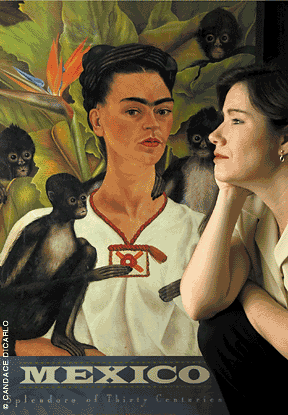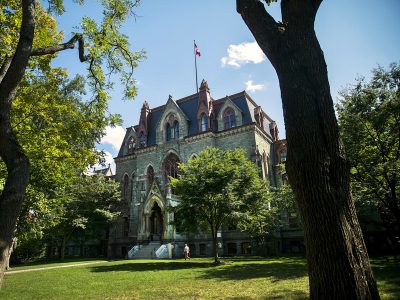
Diversity | It’s the day after an event at La Casa Latina, and the center’s energetic director, Anamaria Cobo de Paci, is urging everyone who stops by to fill up on black beans, chicken, and plantains.
Marking its fifth anniversary, La Casa is much more than a place to find tasty leftovers. It’s a busy center of activity and resources for Penn’s diverse population of Latino students—as well as anyone interested in Hispanic culture. For some, it has become the spot on campus that feels most like home.
Carlos Hernandez, a sophomore from Los Angeles, sums up the feeling that he gets at La Casa in one word: “family.”
“It was hard for me to meet Latinos on my own, because I had no idea where they were,” he recalls. “There weren’t any in my hall, and in my classes, I was usually the only one.” But at La Casa, “I met a lot of people who are like me and were also making that same kind of transition. They opened their arms and opened their doors to me.”
“Sometimes I think of it as a sanctuary where I can go and put down all my other hats and just be myself,” says Celia Castellanos, a Wharton senior who serves on La Casa’s advisory board and works on La Vida magazine.
Formed in 1999, La Casa became the first ethnicity-specific cultural center on campus. La Casa’s neighbors at 3601 Locust Walk now include Makuu, the Black Cultural Resource Center, and the Pan-Asian American Community House.
Though its very presence on campus represents a victory in terms of visibility and resources for minority students, many point to the unfinished business of increasing Latino representation on campus. According to data from the Office of Institutional Research and Analysis, 6.5 percent—or 158 out of 2,433 U.S. and international students—self-identify as Chicano, Puerto Rican or Latino in the Class of 2008.
“There’s a lot that happens in this little space,” says Cobo de Paci, giving a tour of the center, which is decorated with ceremonial masks, woven textiles, and a mosaic honoring Latino heroes such as Frida Kahlo and César Chavez.
On any given day, La Casa could be showing a documentary, hosting an information session by Career Services, or holding its Latino Dialogue Institute. The latter is a certicate program that brings together students to discuss issues ranging from immigration to urbanization. “Because the Latino community is expanding tremendously,” Cobo de Paci explains, “people just want to grab hold of that more and understand a piece of that, because they know it’s the wave of the future.” Spanish conversation tables are another draw to the center for Latino and non-Latino students.
La Casa also advises and collaborates with the student organizations that make up Penn’s Latino Coalition. Five years ago, there were just a handful of groups; now there are 19,ranging from the Society of Hispanic Professional Engineers to the Penn Brazilian Club and Alianza: Jewish and Latino Partnership.
Since La Casa was created, there’s been an “explosion of diversity” among these groups, says Jesse Salazar, a senior from Dalton, Pennsylvania, and spokesman for the Latino Coalition. In addition, “The number of resources available, the mentoring … and access to the University has really increased for Latino students.”
Representatives of various University offices, from financial aid to academic support services, meet with students at La Casa throughout the year. “One thing we push a little here is to make sure … that [students] don’t only experience La Casa,” Cobo de Paci says. “They understand there’s a whole big experience of getting involved in Penn life.” As a result of this outreach, she says, “We have more RA’s that are Latinos, we have more work-study students working in different offices. This year we have two Latinos running the Greek system, and that’s never happened.”
Penn’s Latino and Latin-American students come from 22 countries and throughout the United States. “We’re from all different walks of life in this community,” says Cobo de Paci, who herself is part Colombian and part Ecuadoran. That diversity is mainly an asset, though the groups sometimes differ in their priorities.
“The issues we’re interested in [as U.S. and international students] are different,” says Andrea Puig, president of Mex@Penn. A large focus of her group is keeping alive Mexican cultural traditions, such as the Day of the Dead. Social issues that are big in the United States, such as Affirmative Action, are less of a priority, Puig says. “On the other hand, we’re very interested in international issues. We love it when a club like Colombia brings a speaker from the Association of American States to talk about Latin America.”
Interactions among groups have improved over the past several years, according to Cobo de Paci. Though students may identify with individual groups, everyone comes together for big events, such as the annual Cultural Festival.
In addition to making an impact at Penn, La Casa has become well known in Philadelphia’s Latino community for the community-service work done by its volunteers, such as tutoring in English as a second language.
The center also hosts a college day for local high-school students. “We understand these students might not come to Penn, but as long as they know about college, that’s really our goal.”
Students here have benefited from mentoring, as well. Penn graduates have become increasingly involved with the University through the Association of Latino Alumni.
“The alumni contribute [to La Casa] as speakers, they’ve donated things, and they have served as mentors as part of the Latino Professional Pathways program,” Cobo de Paci says. “That kind of involvement is only going to continue to grow.”
Alumni participation hasn’t always been so strong, observes ALA president Carmen Maldonado C’91 GEd’92. When she was a student at Penn, “We didn’t know who [the alumni] were, so we very much felt as though we were inventing the wheel,” she recalls. “It was hard to build off what previous generations may have succeeded in doing.”
In her visits back to campus, she’s been impressed with La Casa “as a safe place for students to talk about their experiences,” adding that “there are more outlets for students to engage culturally in terms of who they are and where they’ve come from … and to build that support group necessary to graduate from a place like Penn.”
In addition to contacting as many Latino alumni as possible—including those who had lost touch with Penn—ALA has given away its third Latino student scholarship this fall and has raised almost $200,000 from alumni to endow its scholarship program.
“[We want to make] sure as alumni we can be supportive of students being and staying at the University,” she says. “Many of us experienced having friends disappear because they weren’t able to stay at Penn for financial issues.”
ALA also wants to connect with students so “they understand life as a Penn person doesn’t end when you graduate … that there’s a place for them to still have a voice on campus.”
Despite the strides of the past five years, a number of student leaders desire more representation on campus for Latinos.
“I would like to see more Latino students [at Penn] in general,” says Carlos Hernandez, a member of the Mexican-American student group, MEChA, as well as the Latino Coalition advisory board. “As far as subject matter in certain classes go, the Latino perspective is rarely told.” Hernandez describes a writing class he took that focused on urban schooling: “A lot of the texts that we read were about black communities and poor white communities. I was the only Latino person. So I felt like it was my responsibility every day in class to interject [my perspective].” Compared to his high school with a predominantly Latino population, the Latino presence at Penn is so small that individuals “have to become spokespersons for the whole community,” he says. “Some people don’t want to do it. If that person can’t live up to that [responsibility], then some bad images can be portrayed.”
Salazar cites student recruitment as the top issue for the Latino Coalition. “Even though Latinos represent about 15 percent of the U.S. population, they only represent between six and eight percent of the class,” he said.
“[Penn President] Amy Gutmann has said she wants to work with us [on Latino admissions]. We’re very excited. She has even made offers to go into high schools herself and speak with students in different areas. In the past Penn was having recruiting events in four-star hotels in L.A. A lot [of students find it] intimidating if they have to go to a ritzy area.”
The coalition also supports recruiting and granting tenure to more Latino faculty, and would like more classes and faculty specializing in Latino and Latin-American studies, which is a new program on campus, Salazar says. “We’re excited to work with [Dr. Gutmann] because she has a proven track record at Princeton of recruiting more minority faculty members into the ranks and helping to make sure the scholarships of diverse groups are represented in the curriculum.” —S.F.




